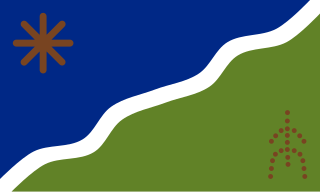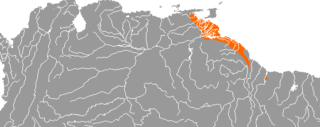Related Research Articles

Mapuche is an Araucanian language related to Huilliche spoken in south-central Chile and west-central Argentina by the Mapuche people. It is also spelled Mapuzugun and Mapudungu. It was formerly known as Araucanian, the name given to the Mapuche by the Spaniards; the Mapuche avoid it as a remnant of Spanish colonialism.

This is a list of different language classification proposals developed for the indigenous languages of the Americas. The article is divided into North, Central, and South America sections; however, the classifications do not correspond to these divisions.

Comecrudan refers to a group of possibly related languages spoken in the southernmost part of Texas and in northern Mexico along the Rio Grande of which Comecrudo is the best known. Very little is known about these languages or the people who spoke them. Knowledge of them primarily consists of word lists collected by European missionaries and explorers. All Comecrudan languages are extinct.

The Chonan languages are a family of indigenous American languages which were spoken in Tierra del Fuego and Patagonia. Two Chon languages are well attested: Selk'nam, spoken by the people of the same name who occupied territory in the northeast of Tierra del Fuego; and Tehuelche spoken by the people of the same name who occupied territory north of Tierra del Fuego. The name 'Chon', or Tshon, is a blend of 'Tehuelche' and 'Ona'.

Barbacoan is a language family spoken in Colombia and Ecuador.

The Kawésqar, also known as the Alacalufe, Kaweskar, Alacaluf or Halakwulup, are an indigenous people who live in Chilean Patagonia, specifically in the Brunswick Peninsula, and Wellington, Santa Inés, and Desolación islands northwest of the Strait of Magellan and south of the Gulf of Penas. Their traditional language is known as Kawésqar; it is endangered as few native speakers survive.
Máku, also spelled Mako, and in the language itself Jukude, is an unclassified language and likely language isolate once spoken on the Brazil–Venezuela border in Roraima along the upper Uraricoera and lower Auari rivers, west of Boa Vista, by the Jukudeitse. 300 years ago, the Jukude territory was between the Padamo and Cunucunuma rivers to the southwest.
Chimuan or Yuncan is a hypothetical small extinct language family of northern Peru and Ecuador.
Lencan is a small family of nearly extinct indigenous Mesoamerican languages.
Katukinan (Catuquinan) is a language family consisting of two languages in Brazil, Katukina-Kanamarí and the perhaps moribund Katawixi. It is often not clear which names in the literature, which are generally tribal names and often correspond to dialects, refer to distinct languages. Indeed, they're close enough that some consider them all to be dialects of a single language, Kanamari.

Harakmbut or Harakmbet is the native language of the Harakmbut people of Peru. It is spoken along the Madre de Dios and Colorado Rivers, in the pre-contact country of the people. There are two dialects that remain vital: Amarakaeri (Arakmbut) and Watipaeri (Huachipaeri), which are reported to be mutually intelligible. The relationship between speakers of the two dialects is hostile.

Sechura–Catacao is a proposed connection between the small Catacaoan language family of Peru and the language isolate Sechura (Sek). The languages are extremely poorly known, but Kaufman (1990) finds the connection convincing, Campbell (2012) persuasive.
Pasto is a purported Barbacoan language that was spoken by indigenous people of Pasto, Colombia and Carchi Province, Ecuador. It is now extinct.

Warao is the native language of the Warao people. A language isolate, it is spoken by about 33,000 people primarily in northern Venezuela, Guyana and Suriname. It is notable for its unusual object–subject–verb word order. The 2015 Venezuelan film Gone with the River was spoken in Warao.
The Tiniwan languages are two extinct and one moribund language of Colombia that form a small family.
Taruma (Taruamá) is a divergent language of northeastern South America. It has been reported to be extinct several times since as far back as 1770, but Eithne Carlin discovered the last three speakers living in Maruranau among the Wapishana, and is documenting the language. The people and language are known as Saluma in Suriname.

Otomaco and Taparita are two long-extinct languages of the Venezuelan Llanos.

Kukurá is a spurious language, fabricated by an interpreter in Brazil.

The Marañón River basin, at a low point in the Andes which made it an attractive location for trade between the Inca Empire and the Amazon basin, once harbored numerous languages which have been poorly attested or not attested at all. Those of the middle reaches of the river, above the Amazon basin, were replaced in historical times by Aguaruna, a Jivaroan language from the Amazon which is still spoken there. The languages further upriver are difficult to identify, due to lack of data. The region was multilingual at the time of the Conquest, and the people largely switched to Spanish rather than to Quechua, though Quechua also expanded during Colonial times.
Puruhá and Campbell (2012) is a poorly attested extinct language of the Marañón River basin in Ecuador which is difficult to classify, apart from being apparently related to Cañari, though it may have been Barbacoan.
References
- ↑ Doctrina para los viejos chonos (published in Bausani 1975)
- ↑ Ibar Bruce, Jorge (1960). "Ensayo sobre los indios Chonos e interpretación de sus toponimías". Anales de la Universidad de Chile (in Spanish). 117: 61–70.
- ↑ Campbell, Lyle (2012). "Classification of the indigenous languages of South America". In Grondona, Verónica; Campbell, Lyle (eds.). The Indigenous Languages of South America. The World of Linguistics. Vol. 2. Berlin: De Gruyter Mouton. pp. 59–166. ISBN 9783110255133.
- ↑ Adelaar & Muysken, 2005. The languages of the Andes
- ↑ Samitier, Liaras. 1967. El grupo chono o wayteka y los demas pueblos fuegopatagonia. Runa 10. 1-2:123-94 (Buenos Aires).